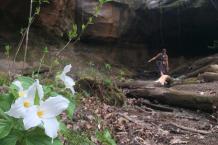Press Release
The Wayne National Forest Makes A List Of 15 Wild Areas At High Risk Of Development For Oil, Gas And Other Resources
David Miller, September 19, 2017
 The Wayne National Forest makes list of 15 wild areas at high risk of development for oil, gas and other resources
The Wayne National Forest makes list of 15 wild areas at high risk of development for oil, gas and other resourcesNew report shines spotlight on important wild lands that must be protected
Columbus, Ohio — A new report released today by The Wilderness Society raises the alarm about the Wayne National Forest and other wild lands across the U.S. threatened by extractive industries eager to exploit the resources on or underneath them, including oil, gas and coal.
‘Too Wild To Drill’ identifies 15 unique public lands that are at high risk of drilling, mining and other development—and the damage and destruction that inevitably follow. These lands provide Americans with important benefits such as clean air and water, wildlife habitat, recreational opportunities, sacred sites, and jobs and other socioeconomic benefits.
“This report is a wake-up call for Ohioans,” said Nathan Johnson, Public Lands Director at the Ohio Environmental Council. “Development in this forest will benefit out-of-state interests by damaging southeast Ohio’s ecology, health, and access to recreation. This land deserves to be protected.”
Energy development damages landscapes, often permanently. Impacts resulting from infrastructure like well pads, oil rigs, roads, fences and pipelines include air and water pollution from haze, spills, chemicals and dust, as well as phenomena like industrial traffic, gas flares and other light pollution, and loud noise that can disrupt communities and wildlife.
“Some places are simply too wild to drill,” said Jim Ramey of The Wilderness Society. “The federal government must resist pressure from energy companies and other special interests to open up our last remaining wild places for development.”
The Wilderness Society issues a new version of ‘Too Wild To Drill’ every few years to call attention to vulnerable places on public lands. In this edition, places highlighted include the Arctic National Wildlife Refuge, one of the most remote and wild places left in the world.
“The Interior Department is required by Congress to manage, on behalf of the American people, almost 450 million acres of public lands for many different purposes, not just energy extraction,” Ramey said. “Yet oil, gas and coal have long had an outsized influence—and footprint—on public lands. It is long past time that we take some of these lands off the table.”
The release of ‘To Wild Too Drill’ falls in the midst of numerous reviews of public lands policies, ordered by President Donald Trump and Interior Secretary Ryan Zinke, that are taking place behind closed doors with little or no public oversight or accountability. In fact, earlier this week news broke of the Trump administration’s secret efforts to roll back protections for several wild places featured in ‘Too Wild To Drill,’ including the Arctic National Wildlife Refuge and the Bears Ears and Grand Staircase Escalante national monuments, presumably to make them available for energy development.
“We must set aside our wildest, most pristine places for future generations to enjoy,” Johnson said. “Selling our public lands for a quick, one-time check is foolish—once they’re gone, we can never get them back.”
